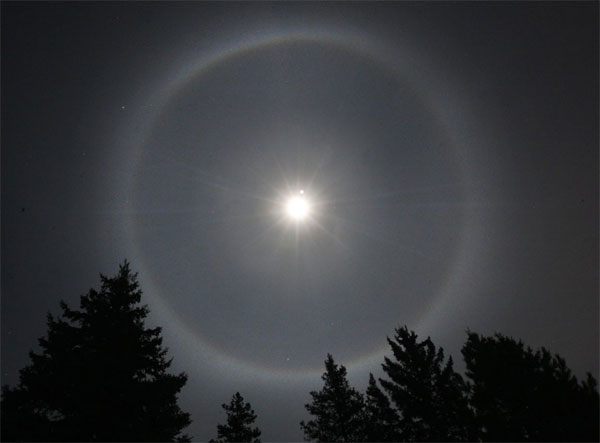Why are there 'halo moon' and 'moon canopy'?
The sentence "the sun and moon halo, the moon canopy rains" Vietnamese people used to forecast the weather so far still show the accuracy is not small.
So when is it called "moonlight" and "moon moon" and folk experience about weather forecasting to understand what it is from a physical perspective.
The bright area around the moon's disk, collectively called the moon's halo, is an optical phenomenon caused by light refraction in the earth's atmosphere. It is caused by light refracted by the moon as it passes through the earth's atmosphere, not the aura that exists around the moon.

"Moon halo" corresponds to the hot weather.(Artwork: Bob King)
Moon halo often corresponds when the weather is hot or very cloudy. When the weather is very dry, there is little water vapor, on the upper floor of the atmosphere only low density ice particles (ice). Light from the moon (which is illuminated by the sun) when entering the atmosphere through these hexagonal crystals is refracted, causing the same phenomenon as passing through a diverging lens, forming a white ring of about 22 degrees (about 44 degrees wide) around the moon.
That is the phenomenon of people often seen in sunny days, dry, less steam, less cloudy. Therefore, when seeing this aura, people often predict that it will be hot and dry in the following days.
When there is a thick cloud layer in the upper atmosphere, containing many frozen water, the light from the passing moon is refracted many times, thus not producing a single angle of refraction, even marked dispersion. At this time, the aura around the moon was not a wide white light, but it was often surrounded by a colorful halo (a bit like a rainbow) and was not separated from the bright moon disc as when it was dry, . This leads to the experience that when the moon "spreads" like that, it is cloudy and it is easy to rain soon.
However, folk experience is not always true but only relative. For example, when the "moon of the halo" , if the halo becomes clearer, the heavier it is, the sky itself can also cause the pressure difference in the atmosphere, generating wind, storm and rain. In addition, depending on the density and number of cloud layers in the atmosphere, sometimes the moon may have both "halo" and "spread" at the same time.
- Why do corals appear around the Sun and Moon?
- Enjoy the halo phenomenon that surrounds the sun in Quang Nam
- NASA shares a rare photograph of a rainbow-like halo surrounding the Moon
- Finally, scientists have unraveled the mystery of ghostly halo on the sea
- After Nghe An, strange aura appeared in Hue sky
- Super moon has appeared
- The halo of the moon appears in England
- Discover the mysterious halo of Saturn
- Lao Cai: The appearance of the 'sun halo' at noon
- What is the sun halo?
- The halo appears foreshadowing a period without rain
- Decipher the mysterious halo before the earthquake
 Is the magnetic North Pole shift dangerous to humanity?
Is the magnetic North Pole shift dangerous to humanity? Washington legalizes the recycling of human bodies into fertilizer
Washington legalizes the recycling of human bodies into fertilizer Lightning stone - the mysterious guest
Lightning stone - the mysterious guest Stunned by the mysterious sunset, strange appearance
Stunned by the mysterious sunset, strange appearance What would a day on the Moon be like for astronauts?
What would a day on the Moon be like for astronauts?  First photo of Mars' strangely shaped moon
First photo of Mars' strangely shaped moon  The biggest supermoon of the year is about to light up the world's skies
The biggest supermoon of the year is about to light up the world's skies  New research shows that Earth has a new 'Moon'
New research shows that Earth has a new 'Moon'  James Webb Telescope Discovers Rare Scene From Saturn's Moon
James Webb Telescope Discovers Rare Scene From Saturn's Moon  Shock Detected on the Dark Side of the Moon: Structure Identical to Earth!
Shock Detected on the Dark Side of the Moon: Structure Identical to Earth! 